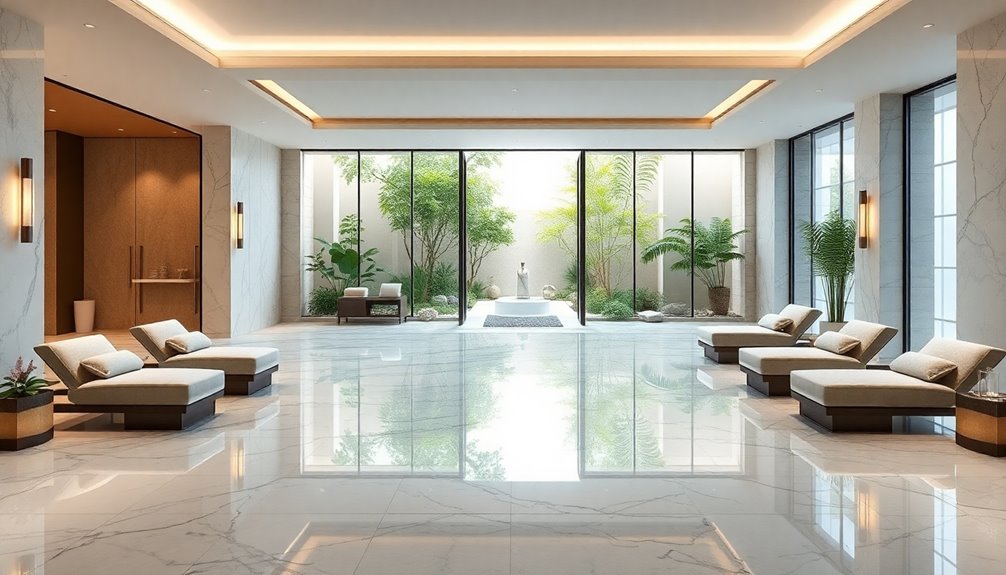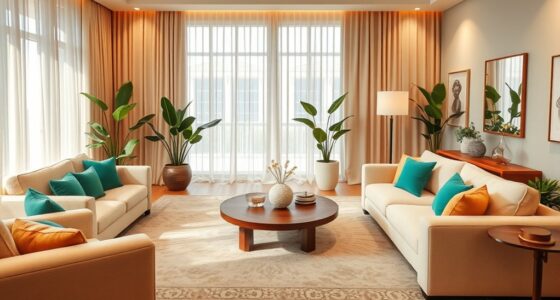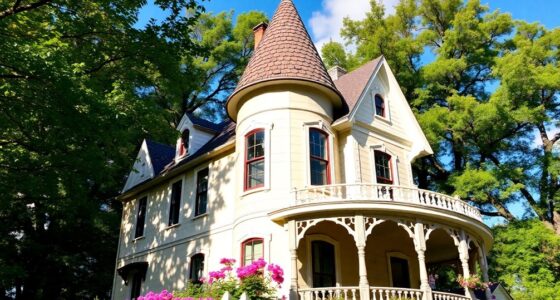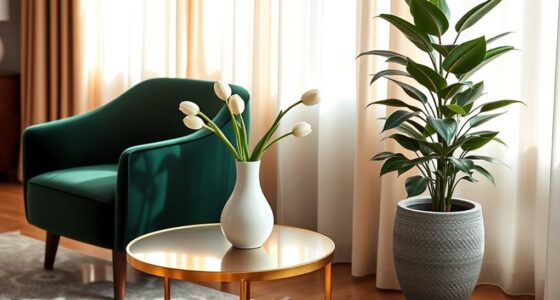To maximize functionality and luxury in your spa floor plan, prioritize an intuitive layout that guides clients smoothly between treatment and relaxation areas. Incorporate soundproof treatment rooms with adjustable lighting for personalized comfort, and guarantee natural light flows in common spaces to enhance tranquility. Use flexible layouts and proper zoning to adapt to client demands while maximizing space efficiency. Emphasize organization in your reception area and include advanced technology for streamlined operations. By focusing on these key elements, you'll create a serene and efficient environment that elevates the overall client experience—discover more about enhancing your design.
Key Takeaways
- Design intuitive layouts that ensure smooth client flow between reception, treatment, and relaxation areas for an enjoyable experience.
- Incorporate soundproof treatment rooms with adjustable lighting to enhance comfort and personalize the environment for each client.
- Utilize natural light in common areas to create a calming atmosphere while maintaining privacy in treatment spaces.
- Implement flexible layouts with movable walls to easily adapt to client demands and future expansion needs.
- Prioritize operational efficiency through proper zoning, minimizing excess square footage and enhancing functionality across the spa.
Key Design Considerations

When designing a spa floor plan, key considerations can make all the difference in creating a serene environment.
Start with the reception area; it's your clients' first point of contact, setting the tone for their experience. A welcoming layout here invites relaxation.
Next, focus on treatment rooms—ensure they're soundproof and equipped with adjustable lighting to enhance ambiance and comfort.
While maximizing space, don't shy away from using natural light in common areas to foster a calming atmosphere. Remember, treatment rooms don't always need windows for privacy.
Additionally, plan an efficient plumbing layout to reduce installation costs and maintenance.
Finally, consider flexible layouts and movable walls to accommodate future expansion, adapting to evolving client demands.
Prioritizing Functionality

Creating a serene environment goes hand in hand with prioritizing functionality in your spa design. To enhance your spa experience and guarantee operational efficiency, focus on these key elements:
- Intuitive Layouts: Design the spa floor plan to facilitate smooth client flow between treatment rooms, relaxation areas, and reception.
- Soundproof Treatment Rooms: Implement soundproofing and adjustable lighting for personalized comfort during treatments.
- Multi-Functional Spaces: Incorporate areas that can adapt based on client demand, minimizing excess square footage.
- Proper Zoning: Separate high-traffic areas from quieter treatment spaces to reduce congestion and promote tranquility.
Spa Layout Examples

How can different spa layouts enhance your overall experience? A well-thought-out spa design can greatly impact your visit.
In a luxury spa, private treatment rooms with upscale amenities create an intimate atmosphere, allowing you to relax deeply. The interior design in these spaces often emphasizes tranquility, featuring soothing colors and natural materials.
Alternatively, a day spa arrangement focuses on efficiency, with quick-service zones that reduce wait times, ensuring you enjoy your treatments without delays.
Health spas blend fitness areas with holistic treatment rooms, catering to your wellness needs. Each layout serves a unique purpose, maximizing functionality and elevating your experience, while also aiming to achieve a revenue per square foot target of $40 to $70.
Elements for Success

The layout of your spa plays a pivotal role in its success, but it's the thoughtful integration of various elements that truly enhances the experience for clients.
Focus on these key components:
- Room Design: Guarantee treatment rooms are soundproof and have adjustable lighting for a personalized spa treatment experience.
- Natural Light: Incorporate ample natural light and soothing color palettes to create a relaxing ambiance.
- Sound System: Install a high-quality sound system to enhance the tranquil environment with calming music.
- Storage Space: Design well-organized storage solutions to keep the reception area clutter-free and efficient, setting the tone for relaxation.
Additionally, consider incorporating angel numbers into the decor or branding, as they can hold significant meanings that resonate with clients on a spiritual level.
Technology in Spa Design

While a serene atmosphere is essential for a successful spa, leveraging technology can elevate the client experience even further. Integrating advanced booking systems can streamline reservations, cutting wait times and improving satisfaction by up to 40%. Smart lighting controls allow you to customize ambiance in treatment rooms, enhancing relaxation.
Here's a quick look at some key technologies:
| Technology | Benefits | Impact on Spa Experience |
|---|---|---|
| Advanced booking systems | Reduces wait times | Enhances client satisfaction |
| Smart lighting controls | Customizable ambiance | Tailored to specific services |
| Client management systems | Efficient operational workflow | Fosters convenience |
| High-quality sound systems | Ambient sounds for relaxation | Improves overall tranquility |
| Digital signage | Increases product visibility | Boosts retail sales |
Incorporating Wi-Fi further supports these innovations, enhancing the overall spa experience. Additionally, using essential oils in treatment rooms can complement the technology by enriching the atmosphere and promoting relaxation.
Sustainability in Spa Planning

As you plan your spa, incorporating sustainability isn't just a trend—it's a responsibility.
By embracing eco-friendly practices, you can create a luxurious experience while reducing your environmental impact. Here are some key strategies to take into account:
- Energy-efficient systems: Install LED lighting and low-flow water fixtures to cut operational costs.
- Eco-friendly products: Use organic and sustainably sourced materials for treatments to attract eco-conscious customers.
- Waste management: Implement recycling and composting programs to minimize waste and enhance sustainability.
- Local partnerships: Source products from local businesses to support the community and lower transportation emissions.
Enhancing Client Experience
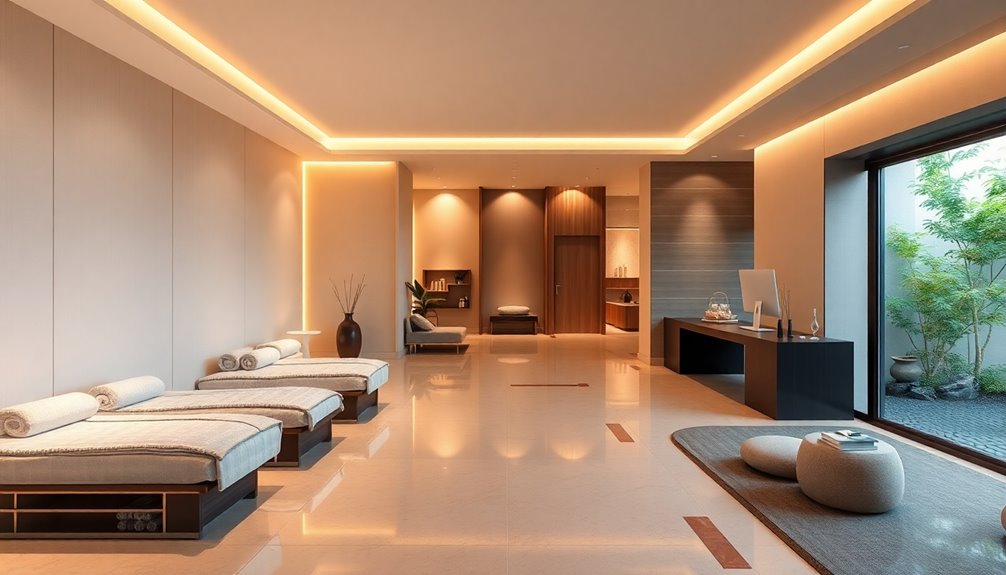
Creating a sustainable spa environment not only benefits the planet but also enhances your clients' experience. The thoughtful design of your space can set a positive tone right from the reception area. Consider these key elements:
| Element | Purpose | Benefit |
|---|---|---|
| Comfortable Seating | Welcomes clients warmly | Sets a positive tone |
| Water Features | Promotes relaxation | Elevates ambiance |
| Refreshment Stations | Offers healthy options | Increases satisfaction |
Incorporating personalized service areas allows clients to engage with staff about their treatments, fostering a sense of care. Finally, integrating technology, like streamlined booking systems, enhances efficiency and educates clients, ensuring a satisfying experience.
Frequently Asked Questions
How Can I Incorporate Local Culture Into My Spa Design?
To incorporate local culture into your spa design, start by researching the area's traditions, art, and natural elements.
Use local materials and colors that reflect the community's heritage.
Consider adding artwork or decor from local artists to create a unique atmosphere.
You could also integrate traditional healing practices or treatments inspired by the locale.
This approach not only enhances your spa's appeal but also fosters a deeper connection with your guests and their experiences.
What Are the Best Materials for Spa Flooring?
When you're choosing the best materials for spa flooring, consider options that blend durability with comfort.
Natural stone, like slate or marble, offers elegance and is easy to clean.
Bamboo and cork are eco-friendly choices that provide warmth underfoot.
Avoid overly slippery surfaces, especially in wet areas.
If you're looking for something more budget-friendly, luxury vinyl tiles can mimic natural materials while being moisture-resistant.
Ultimately, prioritize aesthetics and practicality for your spa's ambiance.
How Much Space Is Needed for Treatment Rooms?
When planning treatment rooms, you'll want to allocate at least 120 to 150 square feet per room.
This space allows for a treatment table, storage for equipment, and enough room for you and your clients to move comfortably.
If you're considering additional features, like a sink or seating area, you might need even more space.
Always think about creating a relaxing environment, as comfort plays a huge role in client experience.
What Lighting Works Best for Relaxation Areas?
When it comes to lighting for relaxation areas, you'll want to focus on soft, warm tones that create a calming atmosphere.
Consider using dimmable LED lights, as they allow you to adjust the brightness to suit different moods. Incorporating natural light through windows can also enhance the space, but use sheer curtains to diffuse it.
Don't forget about adding candles or salt lamps for a cozy touch that promotes tranquility during your relaxation time.
How Can I Effectively Market My Spa's Unique Design?
Think of your spa as a serene oasis, much like an ancient Roman bathhouse that invites rejuvenation.
To market your unique design effectively, showcase stunning visuals on social media, highlighting the ambiance and elements that set you apart.
Collaborate with local influencers to reach a broader audience.
Create engaging content that tells your spa's story, emphasizing how your design enhances relaxation and well-being.
Don't forget to utilize special promotions to entice first-time visitors!
Conclusion
In the world of spa design, you're not just creating a space; you're crafting an oasis where serenity flows like water. By balancing functionality and luxury, you can transform an ordinary layout into a haven of relaxation. Embrace technology and sustainability to elevate the experience, ensuring every corner whispers tranquility. As you blend these elements, remember: a well-designed spa is a symphony of comfort, inviting clients to unwind and escape the chaos of everyday life.
